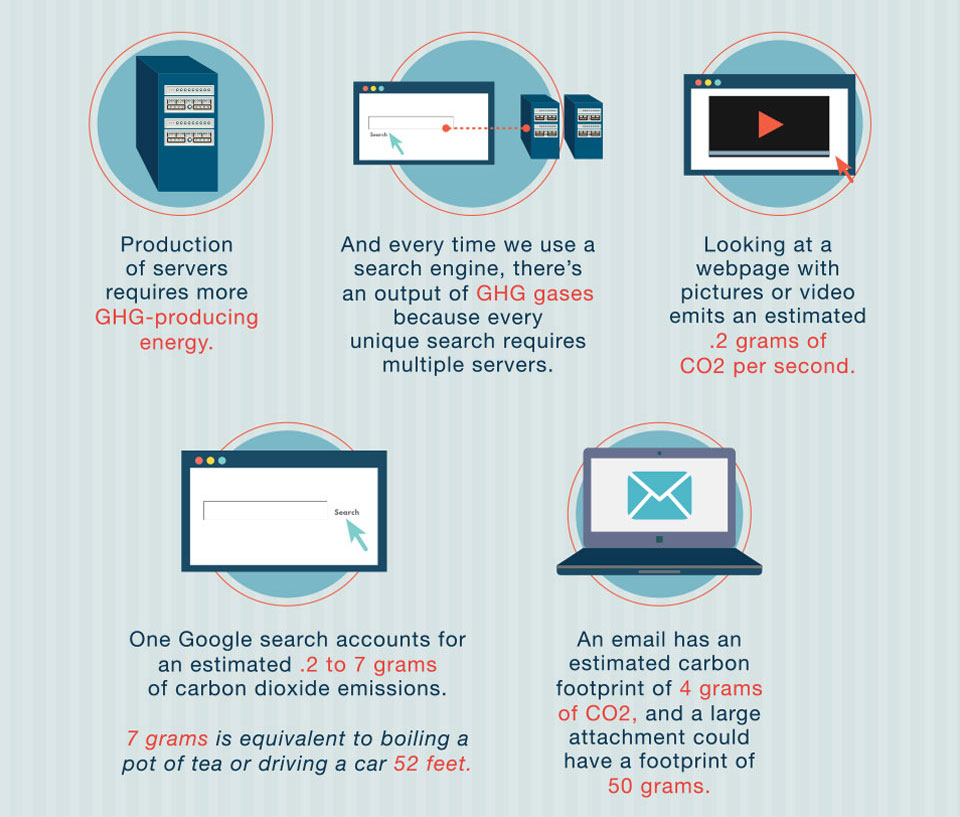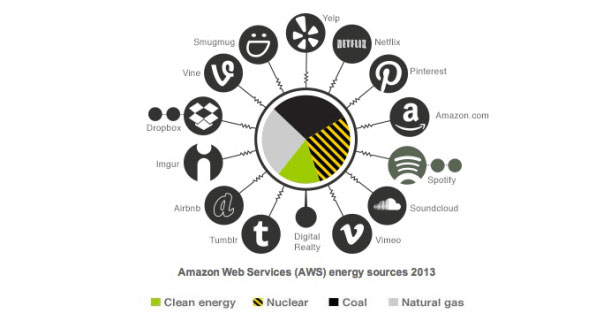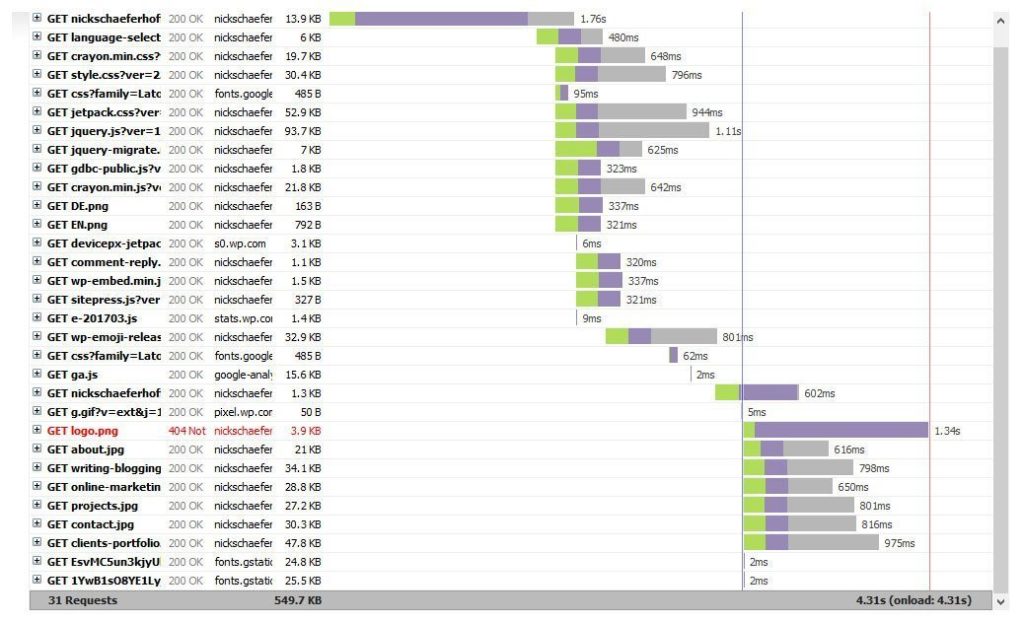“What is an eco-friendly website? How can a website be bad for the environment!? It’s not even a real thing!”
Does the above might mirror your first reaction? I don’t blame you. It’s hard to imagine something which is completely virtual to have an impact on the real world.
And yet, the Internet contributes two percent of global carbon emissions. While that may not sound like much, it is, in fact, the same as the greenhouse-gas emissions of the aviation industry.
Where on earth do they all come from? Many factors contribute to the effect the web has on our environment. The main two are:
- The devices we use to surf online
- The server farms and data centers that store websites, process search queries and hold the web’s content
All of them need to be produced, shipped, powered and, in the case of the servers, kept cool. Naturally, this uses energy and, consequently, produces harmful emissions. For more details, check this infographic.
In the following, we’ll discuss some simple steps you can take toward a greener web presence.
But first…
Why is an Environmentally Friendly Website Important?
There’s quite a lot of information online about living sustainably and the impact our decisions have on the environment and future generations. More and more people try to live in a way that minimizes their impact, for example, through recycling, reduction of energy consumption, changing their diet, and other measures.
In addition to that, there is an increase in products being marketed as green or eco-friendly. However, rarely are these terms applied to websites or the Internet at large.
A probable reasons for that is that a lot of people are unaware of the environmental impact of online activity. Yet, as mentioned in the introduction, it is quite significant.

As early as 2016, the IT sector was responsible for approximately 7 percent of global electricity use. This is due to the technology used to power and access the web as well as the sheer and growing number of people who do so.
As of 2019, there are over 4.3 billion active Internet users in the world. This number is only expected to grow as more and more people gain online access and more companies go digital.
For that reason, just like in the real world, it is important to take measures to reduce the impact the web has on the climate and environment. And the only place where you can start is with yourself.
What’s in it for You?
Going green with your website comes with several benefits for both you, your business and your clients.
- Reduce your carbon footprint — If you are one of the growing number of people who want to take action against climate change and other environmental problems, here’s a way you can do so. Transitioning to a more eco-friendly website is one more step to reducing your personal carbon footprint.
- Connect with your customers — You are not alone in your efforts. Studies have shown that consumers are becoming more environmentally concerned. As a consequence, they are seeking out businesses that care about this topic as well. Consequently, being on the forefront of this development is a good way to attract like-minded customers and business associates.
- Improve your bottom line — As you will see below, opting for more eco-friendly ways to run your web presence can if often congruent more user friendliness and increased site quality. This makes good business sense and can improve your overall success in the market place.
What are Some of the Challenges?
So, if having a greener website is such a positive step to take, why aren’t people following this model?
Maybe you don’t know where to start. Or you might feel like you lack the technical skills for taking the steps towards a more environmentally friendly web design.
One of the biggest challenges in creating more eco-friendly websites is faced by the people who make them – developers and designers. While you may be interested in making things that have less of an impact on the environment, what happens when your client is not?
After all, the main focus for most people who want a website is probably the functionality and design. Carbon footprint is usually not something they immediately think of.
A lack of education is another great challenge. There’s often a notion that going green takes a lot of effort and means sacrificing things you care about.
However, as you’ll see below, reducing your site’s carbon footprint does not have to mean a reduction in quality. Want proof?
Examples of Eco-Friendly Websites
The truth of the matter is that websites that incorporate low-impact approaches already exist.
One such example is WholeGrain Digital. They are a web design agency who create and design WordPress sites for clients. Their blog and overall web design focus is on creating them in a sustainable manner.

For example, you will notice that they’ve opted for a simple and clean design. Unlike many sites these days there are no ads or GIFs running in the background, which can be a huge energy drain.
Another example is ThoughtCo, a 20-year-old informative/educational website. Similar to the other entry on this list, they, too, have opted for a simpler design without moving elements.

Both of these sites demonstrate that’s it’s possible to have an eco-friendly website that isn’t boring. How can you do the same? Let’s talk about that next.
How to Make Your WordPress Website Greener
Here are a few simple ways to make your website less taxing on the environment.
1. Choose the Right Web Host
One of the biggest steps you can do to reduce your website’s environmental impact is to find a web host that has the same goal.
Hosting companies own the physical data centers that contain your and other people’s websites. How they choose to get their energy needs met has a direct impact on how environmentally friendly your own website is.

Consequently, the first step in improving your site’s carbon footprint is to choose a green host. That means, their servers are powered by renewable energy, the companies make use of energy use offsets, and adhere to other environmentally-conscious practices.
2. Get Your Energy from Renewables
What goes for the computers serving up your website to visitors also extends to the equipment you use to build websites. Yours or other people’s.
When running or taking care of a web presence, chances are you are spending a lot of time on a computer. Come to think of it, if you do any work these days, chances are pretty good a good chunk happens in front of a screen. Like servers, these use up energy. So do all other appliances in your work environment.
Therefore, to reduce the footprint of you and your website, switching over to an energy provider running on renewables is a good idea. If you are in the US, you can find some here.
3. Opt for an Eco-Friendly Website Design
Here’s the long and the short of it: The more complicated your site design is, the more energy it consumes when loaded.
Each element of your site – the graphics, animations, code, etc. has a bearing on the energy footprint. Sites that load slowly draw more energy, and so do frequent server requests.

Doing simple things such as using fewer Javascript widgets, reducing the number of images and videos, and making sure that your site loads faster can make a huge difference.
In addition to that, by focusing on what is absolutely necessary, you might just make your site more user friendly in the process. Studies have shown that users prefer less complicated websites as they’re easier to navigate.
4. Have Print-Friendly Content
Does the following scenario sound familiar? You read something interesting or important on the web and need a hard copy of it. You quickly click on print to get it.
Yet, when you get to the printer, you realize that some of the graphics aren’t showing properly. So, you make a few changes and print it again only to find that now some of the text isn’t showing. This type of thing repeats a few times until you finally have your printout, plus a much larger “note paper” pile.
To spare yourself and others this kind of experience, it’s important to make your content printer-friendly. Doing so will reduce the number of times people will have to re-print it, saving energy and resources in the process.
Luckily, there are plugins you can use to achieve that like Print, PDF, Email by PrintFriendly.
5. Improve Your Site Speed
As already mentioned, a slow website is one that uses a lot of energy. Besides that, users also really hate slow-loading websites. So much so, that page speed is a ranking factor to Google, including for mobile.
If that is not going to convince you to make page loading speed a priority, I don’t know what will. If you are set to make your site blazingly fast, here are the right articles for you:
- How to Speed Test Your Website (Metrics, Tools, Optimization Tips)
- 14 Ways To Speed Up WordPress And Decrease Page Load Time
- 9 Advanced Techniques to Make WordPress Faster
6. Educate Your Visitors
The thing about trying to save the planet is that you can’t do it alone. There are over seven billion of us and we can only make significant changes if we do it together.
So, besides sticking a green website sticker in your footer, another step you can take is to make your users aware of their own carbon emissions.
An example of how to do this without sounding condescending or trying to enforce your views can be seen on Loco2. This is an online booking service for train travel in the UK and Europe.
When you use their service to plan a trip, besides just giving you the costs, the site will also let you know how much carbon emissions you’re saving by choosing that route.

This encourages visitors to start or continue to play their part making a difference. If you can do similar things with your site or service, go ahead!
Running an Eco-Friendly Website Isn’t Complicated
Due to its virtual nature, it’s easy to forget that the existence of the Internet has real-life consequences. Since all that data has to live somewhere, everyday technology usage is ramping up its environmental toll.
With more and more people having accessing the web, this will only increase. As a consequence, there has never been a better time to take steps to reduce your personal footprint and that of your site. In this article, we’ve given you the first steps to do so:
- Choose an eco-friendly web host
- Power your work environment with green energy
- Stick to simpler designs
- Remember to make your content printer-friendly
- Reduce the loading speed and make your site faster
- Educate others about their carbon footprint
The cool thing is that many of these practices improve both your environmental impact as well as the user experience. Why not take advantage of a win-win situation?
How do you attempt to make your website greener? Any additional tips to share? Please let us know in the comments section below!
The post 6 Ways to Create a More Eco-Friendly Website (Design, Hosting & More) appeared first on Torque.
